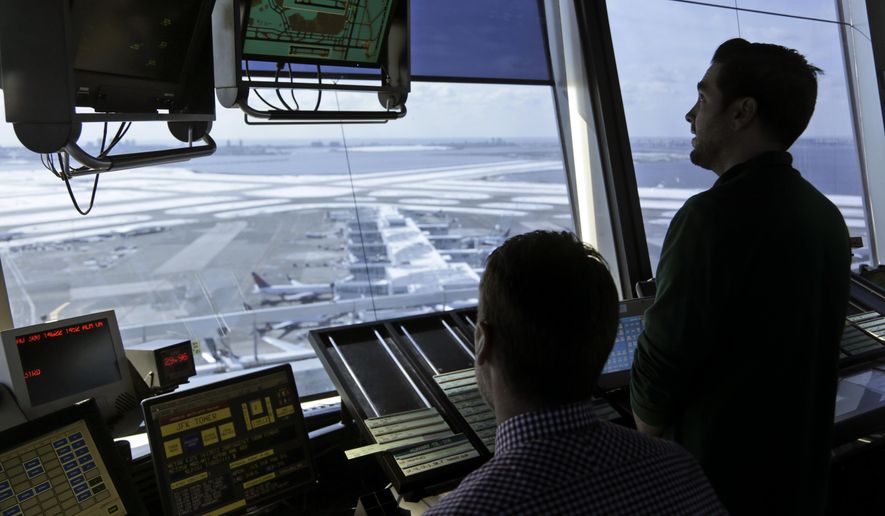WASHINGTON (AP) - The U.S. air traffic control system, the world’s largest and most complex, is in the midst of an era of unsurpassed safety. There has not been a fatal crash of a domestic passenger airliner in the U.S. in eight years.
Now President Donald Trump is looking to shift responsibility for the system from the government to a private, nonprofit corporation run by airlines and other aviation interests. The handover of about 300 airport towers and other flight tracking centers would be one of the largest transfers of U.S. government assets. About 35,000 workers, including 14,000 controllers and 6,000 technicians, would be affected.
Privatization supporters, including some Republican lawmakers, say it would improve efficiency and modernize the air-traffic system. But congressional approval isn’t certain. Some lawmakers in both parties are reluctant to give up oversight. Some politically influential business aircraft operators, private pilots, small aircraft manufacturers and medium- and small-sized airports fear airlines will dominate the corporation’s board, resulting in higher fees for them and less service.
There are also concerns about whether the air traffic system would suffer during the transition.
Some questions and answers about what’s at stake:
WHY MESS WITH A GOOD THING?
The idea is to remove air traffic control from the vagaries of the government budget process, which has limited the Federal Aviation Administration’s ability to commit to long-term contracts and raise money for major expenditures.
That’s hampered the agency’s “NextGen” program to modernize the air traffic system by switching from radar and radio communications to GPS surveillance and digital voice and text communications. Recent controller furloughs and government shutdowns have worsened the problem.
___
WHAT IS THE SITUATION IN OTHER COUNTRIES?
Many countries have created government-owned corporations, independent government agencies or quasi-governmental entities. Canada is the only country to create what is clearly a private nonprofit air-traffic corporation. NavCanada can raise private capital, make long-term financial commitments, and it recently lowered the fees it charges airlines.
But the nonpartisan Congressional Research Service reported last month that there appears to be no conclusive evidence that any of those approaches is better or worse than government-run services, including the FAA’s, in terms of productivity, cost-effectiveness, service quality, and safety and security.
___
WHO WANTS TO DO THIS?
The U.S. airline industry has been campaigning since the 1980s to privatize air traffic control to try to gain greater control over the system, reduce their costs and replace airline passenger ticket taxes with user fees based on takeoffs, landings and other operations. The Clinton administration proposed spinning off air traffic operations into a government corporation but ran into congressional opposition.
House Transportation and Infrastructure Committee Chairman Bill Shuster, R-Pa., has proposed using NavCanada as a model. But he couldn’t win enough support to bring legislation to the House floor last year, and he faced even greater opposition in the Senate. Trump administration officials have cited Shuster’s bill as a starting point for their efforts.
Shuster received $148,499 in airline industry campaign contributions last year, making him the industry’s top recipient in the House, according to the political money tracking site Opensecrets.org.
___
IS NEXTGEN IN TROUBLE?
The FAA has been working for more than a decade on NextGen. Early on, it predicted the program would be completed by 2025, but officials now describe NextGen as an evolving effort with no end date.
The National Academy of Sciences reported in 2015 that the original vision for NextGen of transforming the air traffic system has devolved into a series of incremental changes that primarily emphasize replacing aging equipment and systems.
But FAA Administrator Michael Huerta said recently the agency has made “tremendous progress” revamping the system with the latest technology, and is poised to switch from ground-based radar to GPS surveillance. The switch is expected to save time and fuel and lower greenhouse gas emissions. Huerta has predicted $13 billion in benefits to the government and aircraft operators by 2020, with greater gains after that.
Calvin Scovel, the Transportation Department’s inspector general and a frequent NextGen critic, recently told the House transportation committee that even though the program hasn’t met expectations, it’s not broken.
___
WOULD PRIVATIZATION HELP?
Privatization supporters complain that the FAA’s procurement process is so cumbersome that new equipment is no longer the latest technology by the time it’s acquired. Also, delays in updating landing and takeoff procedures to incorporate technological advances make the system less efficient. Airlines say that costs them billions of dollars in flight delays each year.
A corporation would be free of such government regulations and could act faster and with more flexibility, supporters say. The FAA would still provide safety oversight.
Opponents say there’s no evidence a corporation run by airlines would do a better job. Major U.S. airlines have suffered massive computer outages in recent years that have roiled air travel.
___
WHERE DO AIR TRAFFIC CONTROLLERS STAND?
Their union, the National Air Traffic Controllers Association, endorsed Shuster’s bill after winning assurances that controller wages, benefits and collective bargaining rights would be protected. Union leaders say controllers are tired of working with outdated equipment and are concerned about government shutdowns and furloughs.
___
Follow Joan Lowy at https://twitter.com/AP_Joan_Lowy




Please read our comment policy before commenting.